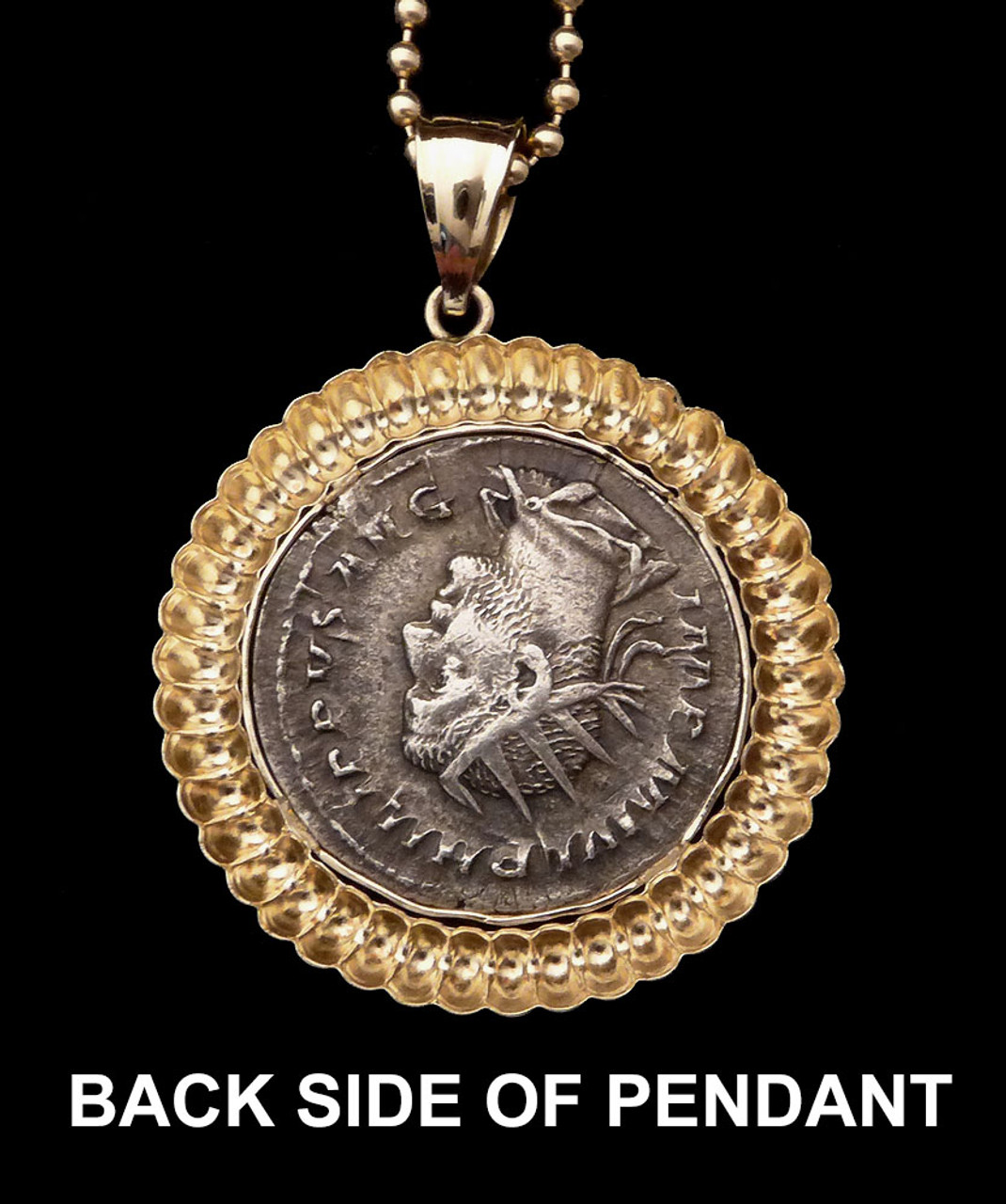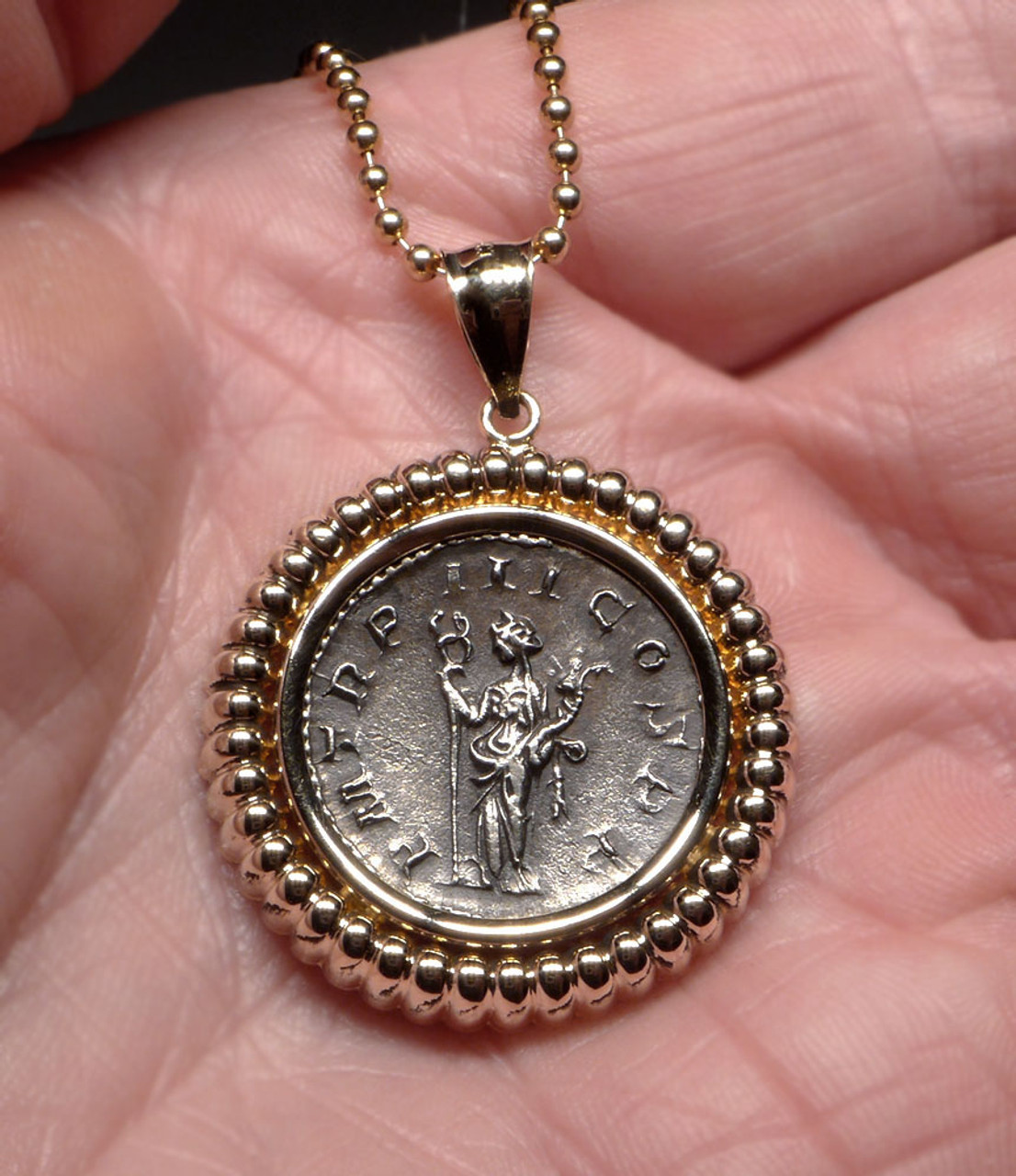Product Description
Minted under the rule of emperor Philip I from 244 - 249 AD, this genuine ancient Roman Imperial silver antoninianus coin pendant in 14 kt yellow gold displays a superbly preserved image of the Roman goddess FELICITAS on the reverse side of the coin. In ancient Roman culture, Felicitas (from the Latin adjective felix, "fruitful, blessed, happy, lucky") is a condition of divinely inspired productivity, blessedness, or happiness. Felicitas could encompass both a woman's fertility and a military general's luck or good fortune. Felicitas is where we get the term 'felicity' meaning intense happiness and joy. The back side of the pendant shows the obverse of the coin which features an equally well-preserved side profile of the emperor Phillip wearing a radiate crown.
This stunning pendant would make a perfect gift to wish a special person GOOD FORTUNE, HAPPINESS and BLESSED FRUITFULNESS. It would make an unforgettable wedding or engagement gift, or a gift for an ideal gift for a new or expecting mother! On this coin, Felicitas is shown standing in long flowing robes, and holding a caduceus and cornucopia. The coin is an exceptional example with a well-centered strike that is crisp and highly detailed due to its excellent preservation. The high-polished 14kt yellow gold pendant setting is stamped with a ribbed design and has a very large bail to accommodate a variety of chain necklaces sizes including large diameters.
The divine personification of Felicitas was cultivated as a goddess. Although felicitas may be translated as "good luck," and the goddess Felicitas shares some characteristics and attributes with Fortuna, the two were distinguished in Roman religion. Fortuna was unpredictable and her effects could be negative, as the existence of an altar to Mala Fortuna ("Bad Luck") acknowledges. Felicitas, however, always had a positive significance.
Felicitas had a temple in Rome as early as the mid-2nd century BC, and during the Republican era was honored at two official festivals of Roman state religion, on July 1 in conjunction with Juno and October 9 as Fausta Felicitas. Felicitas continued to play an important role and was frequently portrayed on coins as a symbol of the wealth and prosperity of the Roman Empire. Her primary attributes are the caduceus and cornucopia. The English word "felicity" derives from Felicitas.
*** Chain is not included but may be purchased additionally, at the link below
GUARANTEE: ALL PURCHASES ACCOMPANIED WITH A WRITTEN GUARANTEE OF AUTHENTICITY
SETTING: 14KT YELLOW GOLD
COIN: SILVER ANTONINIANUS
COIN AGE: 244 - 249 A.D.
DIMENSIONS: 1.2" or 30 mm overall diameter
:::: Includes Gift Box
:::: Includes CERTIFICATE OF AUTHENTICITY / HISTORY SHEET
ADD THE DISPLAYED MEDIUM BEAD CHAIN
MORE ANCIENT ROMAN COIN JEWELRY
HISTORY
Philip the Arab (Latin: Marcus Julius Philippus "Arabs";[3] c. 204 – September 249) was Roman emperor from 244 to 249. Philip the Arab was one of the few 3rd-century Roman emperors sympathetic to Christians, although his relationship with Christianity is obscure and controversial. Some historians believe he was the first Christian Roman emperor. Philip was born in Auranitis, an Arab district east of the Sea of Galilee. The urban and Hellenized centers of the region were Christianized in the early years of the 3rd century via major Christian centers at Bosra and Edessa, but there is little evidence of Christian presence in the small villages of the region in this period, such as Philip's birthplace at Philippopolis. Philip served as praetorian prefect, commander of the Praetorian Guard, from 242; he was made emperor in 244. He quickly negotiated peace with the Persian Sassanid Empire and returned to Rome to be confirmed by the senate. During his reign, the city of Rome celebrated its millennium. In 249, after a brief civil war, he was killed at the hands of his successor, Decius.
Philip had the honor of leading the celebrations of the one thousandth birthday of Rome, which according to tradition was founded on April 21, 753 BC by Romulus. Commemorative coins were issued commemorating the event. According to contemporary accounts, the festivities were magnificent and included spectacular games and theatrical presentations throughout the city. In the Colosseum, in what had been originally prepared for Gordian III's planned Roman triumph over the Persians, more than 1,000 gladiators were killed along with hundreds of exotic animals including hippos, leopards, lions, giraffes, and one rhinoceros. The events were also celebrated in literature, with several publications, including Asinius Quadratus' History of a Thousand Years, specially prepared for the anniversary. At the same time, Philip elevated his son to the rank of co-Augustus.
 US Dollars
US Dollars
 AUD
AUD
 CAD
CAD
 POUNDS STERLING
POUNDS STERLING












